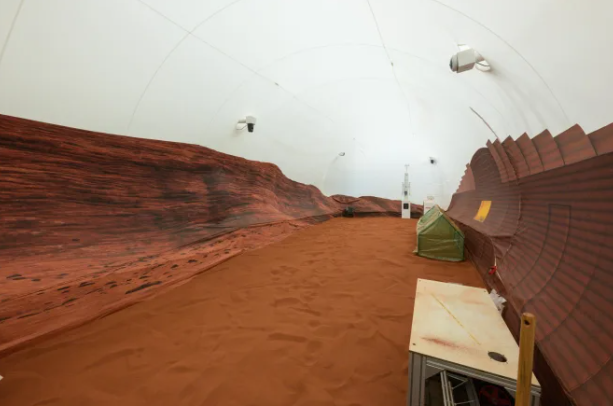NASA’s CHAPEA Project: Preparing for Mars Missions (GS Paper 3, Science & Technology)

Introduction
- NASA’s CHAPEA (CHAllenge and Preparation for Extra-Atmopsheric Activity) project is a groundbreaking initiative aimed at simulating the conditions of a Mars mission.
- Central to this project is “Mars Dune Alpha,” a 1,700-square-foot habitat created with 3D printing at the Johnson Space Center in Houston, Texas.
- This innovative structure includes bedrooms, bathrooms, a work area, a robot station, a gym, and a vertical farm.
- Adjacent to it is a 1,200-square-foot area designed to simulate outdoor Martian activities, complete with red, rocky cliffs and simulated Martian soil to enhance the realism of the experience.
Mission Objectives and Experiences
- The primary objective of the CHAPEA project is to gather data on the physical and mental impacts of a Mars-like environment.
- This includes understanding the effects of isolation, limited resources, and delayed communication.
- These insights are crucial for preparing astronauts for the challenges of long-term space missions.
- Crew members engage in various tasks, from simulated spacewalks to growing vegetables, providing NASA with valuable information on maintaining human health in confined and remote settings.
Participants of the Simulation
- The CHAPEA project selected a diverse team of professionals, including research scientists and doctors, through a rigorous application process that assessed their health, motivation, and professional qualifications.
- The current crew includes Kelly Haston, Anca Selariu, Ross Brockwell, and Nathan Jones, each bringing unique expertise to the mission.
Understanding Mars’ Environment
- Mars presents a hostile environment for human habitation, with rapidly changing temperatures and an atmosphere composed primarily of carbon dioxide.
- The Martian landscape features canyons, volcanoes, and massive dust storms, posing significant challenges for manned missions.
- Beyond preparing for the logistical and moral challenges of Mars exploration, the mission aims to enhance our understanding of the planet’s history and its implications for Earth.
- Following this initial CHAPEA mission, additional simulations are scheduled for 2025 and 2026, with the goal of sending humans to Mars by the 2030s.
India’s Involvement in Martian Exploration
- Alongside NASA's advancements, India's ISRO (Indian Space Research Organisation) has shown significant interest in Mars exploration.
- ISRO's successful 2014 Mars Orbiter Mission (MOM) marked a milestone in interplanetary study.
- As India continues to focus on space exploration, it plans to undertake more Martian missions in the future.
Conclusion
- The CHAPEA project represents a significant step toward realizing human missions to Mars.
- By simulating the conditions of Mars on Earth, NASA is gathering critical data to ensure the safety and well-being of astronauts on future missions.
- The collaboration between NASA and international space agencies like ISRO highlights the global effort to explore and understand Mars, paving the way for potential human settlement on the Red Planet in the coming decades.


